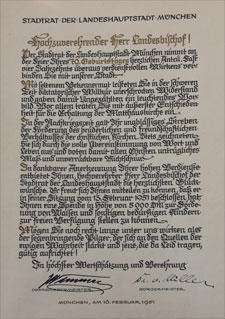Recognition of Regional Bishop Hans Meiser
The “collective experience of resistance” of October of 1934 and the Bavarian regional church’s portrayal of itself as an organization that had resisted National Socialism were projected onto Regional Bishop Hans Meiser (1881-1956) during his lifetime. He was highly esteemed by the churched and unchurched public, politicians and even Jewish congregations in the postwar era and in the young Federal Republic of Germany.
Not only his steadfastness in the regional church’s struggle for autonomy under the Nazi regime but also his contributions to the integration of refugees and the church’s reconstruction in the postwar era attracted notice. He received German and foreign honorary doctorates, the title of honorary resident of the city of Ansbach and the Federal Republic of Germany’s Grand Merit Cross with Star.
Four days after Meiser’s death on June 8, 1956, Munich Mayor Thomas Wimmer (1884–1967) announced that the city of Munich intended to honor his memory for all time (city records, in M.-C. Schobel, Benennung, 5). Thousands streamed to Meiser’s burial in Nuremberg.
In 1960, Matthias Simon summed up the view of the former regional bishop of that day in a biography: The love with which his church was very attached to him and the prevalence and depth of the mourning for him was expressed overwhelmingly at his burial. More than just human, natural emotions came alive there. With Meiser, a man had passed away, who had stood in prophetic grandeur in the pulpit and before the rulers of this world. (M. Simon, Meiser, 416 f.)
Numerous honors intended to hold Meiser in perpetual memory were quickly conferred on him in the church and public sphere. The cities of Munich, Nuremberg, Ansbach, Bayreuth, Schwabach and Weiden in the Upper Palatinate and the town of Pullach near Munich named streets after him. Before the naming of the street in Munich, Meiser was said to have been a fearless opponent of National Socialism (city building commissioner’s letter of January 18, 1957 to the city archive, in M.-C. Schobel, Benennung, 8). Many congregations named their fellowship halls and other church buildings after Meiser. Augustana Theological Seminary in Neuendettelsau, which had been co-initiated by him, also named a building “Meiser House”.
Memorial literature such as Julius Schieder’s book D. Hans Meiser DD. Wächter und Haushalter Gottes published in 1956 was also imbued with deep reverence. At the most, criticism of the former regional bishop was hinted at in conjunction with his conduct during the disputes in the Confessing Church during the Kirchenkampf.
Meiser himself did not have an opportunity to set forth his own view of his role during the Nazi regime. He was no longer able to realize his plans to write an account based on his extensive records of meetings of important church bodies.
This virtually uncritical reverence for Meiser in Bavaria was consistent with the thinking of society as a whole in the young Federal Republic of Germany, which was governed by its repression of entanglements in National Socialism and concentration on reconstruction.
Nothing in other regional churches paralleled the reverence for Meiser, a regional bishop who had held office during the era of the Nazi regime. The premises are also absent, though, because the other bishops, with the exception of Württemberg Regional Bishop Theophil Wurm, had been partly or entirely corrupted. The unparalleled reverence in the 1950s-60s established the conditions for the no less unparalleled deconstruction of Hans Meiser in the recent past.
Source / title
- © 1+2: Private collection of Hans Christian Meiser, Munich; Photos: Nora Andrea Schulze, Munich


